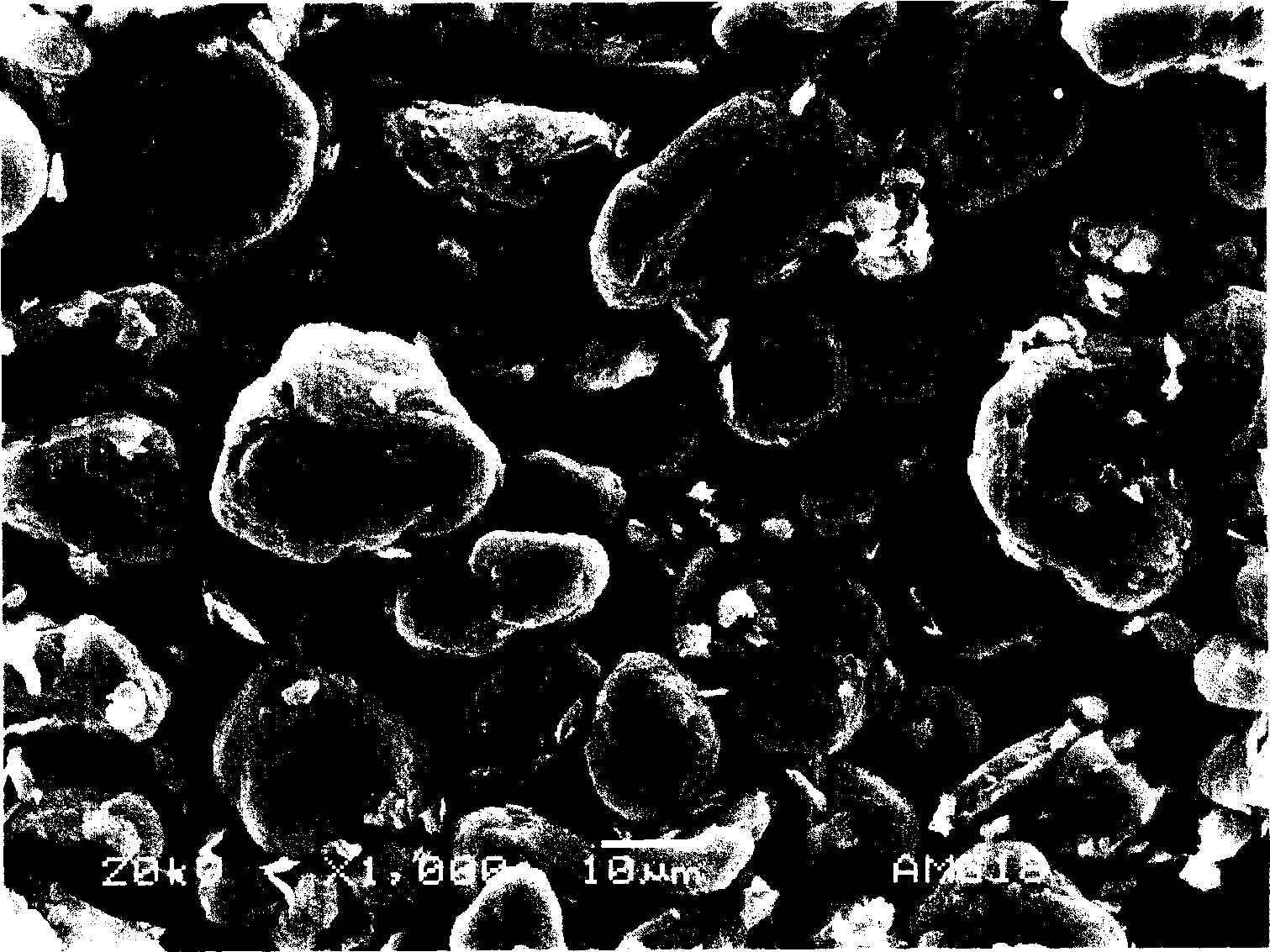Composite graphite negative electrode material for lithium ion secondary cell and its preparation method
A secondary battery and composite graphite technology, applied in the direction of secondary battery, electrode manufacturing, battery electrodes, etc., can solve the problems of low discharge capacity, strong inhomogeneity, poor density of passivation film, etc., and achieve simple process and high discharge capacity High, easily industrializable effect
- Summary
- Abstract
- Description
- Claims
- Application Information
AI Technical Summary
Problems solved by technology
Method used
Image
Examples
preparation example Construction
[0021] The preparation method of the composite graphite negative electrode material of the lithium ion secondary battery of the present invention comprises the following steps: 1. The natural graphite surface is coated with organic matter by liquid phase coating, melting coating and solid phase mixing coating method to obtain coating Graphite; 2. heat-treat the coated graphite at a temperature range of 800°C to 1500°C for 1-6 hours, and fill it with protective gas during heat treatment; 3. After heat treatment, cool down to room temperature, crush and sieve to obtain nuclei, Modified natural graphite with shell structure; 4. Mixing modified natural graphite and artificial graphite according to the mass ratio of 30:70-80:20.
[0022] Organic matter is furan resin, urea-formaldehyde resin, pyrimidine resin, phenolic resin, epoxy resin, polyvinyl alcohol, polystyrene, polymethyl methacrylate, polytetrafluoroethylene, polyvinylidene fluoride, polyacrylonitrile, coke, Coal tar pitc...
Embodiment 1
[0026] High softening point medium temperature petroleum asphalt is crushed to below 3 μm, and the average particle size D 50 =17.931μm, tap density 1.017g / cm 3 , specific surface area 5.3m 2 / g of spherical natural graphite and asphalt powder are fully mixed and bonded, and the mixing mass ratio of asphalt and natural graphite is 1:10; then the above-mentioned coated graphite is heated to 1100 ° C for 2 hours under the protection of nitrogen, and then cooled to room temperature , to obtain coated modified natural graphite, the average particle size D 50 18.4μm, crystal layer spacing d 002 is 0.3358nm. The above-mentioned coated graphite is uniformly mixed with the artificial graphite according to the mass ratio of 50:50 after being pulverized and sieved, as the composite graphite negative electrode material of the lithium ion battery of the present invention, wherein the artificial graphite has an average particle diameter D 50 12.4μm, crystal layer spacing d 002 is 0.33...
Embodiment 2
[0028] Crush the coal tar pitch to less than 3 μm, and the average particle size D 50 =4.8μm, tap density 0.95g / cm 3 , specific surface area 7.5m 2 / g of spherical natural graphite and pitch powder are fully mixed and bonded, and the mixing mass ratio of pitch and natural graphite is 1:10; then the above-mentioned coated graphite is heated to 800°C for 6 hours under the protection of argon, and the temperature is reduced to At room temperature, the coated modified natural graphite was obtained, and its average particle size D 50 5μm, crystal layer spacing d 002 is 0.335nm. The above-mentioned coated graphite is uniformly mixed with the artificial graphite according to the mass ratio of 30:70 after being pulverized and screened, as the composite graphite negative electrode material of the lithium ion battery of the present invention, wherein the artificial graphite has an average particle diameter D 50 2μm, crystal layer spacing d 002 is 0.336nm.
PUM
| Property | Measurement | Unit |
|---|---|---|
| The average particle size | aaaaa | aaaaa |
| Tap density | aaaaa | aaaaa |
| Specific surface area | aaaaa | aaaaa |
Abstract
Description
Claims
Application Information
 Login to View More
Login to View More - R&D
- Intellectual Property
- Life Sciences
- Materials
- Tech Scout
- Unparalleled Data Quality
- Higher Quality Content
- 60% Fewer Hallucinations
Browse by: Latest US Patents, China's latest patents, Technical Efficacy Thesaurus, Application Domain, Technology Topic, Popular Technical Reports.
© 2025 PatSnap. All rights reserved.Legal|Privacy policy|Modern Slavery Act Transparency Statement|Sitemap|About US| Contact US: help@patsnap.com

